SCA-iCeMS symposium held, accelerating Australia-Japan collaboration on stem cell research

From left: Professor Mark Hargreaves, Pro Vice-Chancellor (research partnerships) of the University of Melbourne; Professor Norio Nakatsuji, Founding Director of iCeMS; Professor Martin Pera, SCA Program Leader
15 February 2013
Leading Australian and Japanese experts in bioengineering, nanotechnology, stem cell biology and clinical research met at a two day summit to share ideas and forge plans on how to address some of the big questions in stem cell science.
Hosted by Stem Cells Australia (SCA) at the University of Melbourne, researchers from across Australia joined visiting scientists from Kyoto University's Institute for Integrated Cell-Material Sciences (iCeMS) and Center for iPS Cell Research and Application (CiRA) to explore new collaborative opportunities.
Professor Martin Pera, who leads the SCA initiative and is the Chair of Stem Cell Science at the University of Melbourne, said "Stem cell research is a field with great opportunity but also enormous challenges. These challenges will only be met by an international effort that promotes free exchange of information, collaboration, and effective use of research resources".
The Japanese delegation was led by Professor Norio Nakatsuji, Founding Director of iCeMS, Kyoto University's premier interdisciplinary research initiative with a focus on stem cell science and technology.
Professor Nakatsuji commented, "By facilitating scientific exchange between leading scientists in Stem Cells Australia and iCeMS, we will be able to accelerate the progress of both teams towards applications of stem cells in research and medicine".
Key areas that were identified for future projects include neural and cardiac disease modeling, sharing media and culturing techniques and further strengthening bioinformatics platforms.
Australian delegates included Prof Peter Gray, Director of University of Queensland's Australian Institute for Bioengineering & Nanotechnology (AIBN) and Prof Nadia Rosenthal, Director of Monash University's Australian Regenerative Medicine Institute (ARMI), together with SCA colleagues from CSIRO, Florey Neuroscience Institutes, Centre for Eye Research Australia and University of Melbourne.
The summit was supported by the Australian Department of Foreign Affairs and Trade through the Australia-Japan Foundation.
Symposium Program
Tuesday 12 February 2013
| Session 1: Pluripotency & Reprogramming [Chair: Prof Norio Nakatsuji] | |
|---|---|
| Prof Martin Pera | UoM & FNI & WEHI | A Close Up View of Human Pluripotent Stem Cells |
| Dr Kouichi Hasegawa | iCeMS | Wnt Signaling Orchestration with a Small Molecule DYRK Inhibitor Provides FGF/TGFβ -- Independent Human Pluripotent Cell Renewal |
| Dr Andrew Laslett | CSIRO | Harnessing pluripotency: novel tools for human stem cell biology |
| Dr Knut Woltjen | CiRA & iCeMS | Transposon Systems to Guiding Somatic Cell Reprogramming and Differentiation |
| Session 2: Cardiac [Chair: Prof Nadia Rosenthal] | |
| Dr Itsunari Minami | iCeMS | Robust cardiac differentiation of human pluripotent stem cells under defined, cytokine- and xeno-free conditions |
| Prof Nadia Rosenthal | ARMI | Heart regeneration |
| Dr Shin Kadota | iCeMS | Development of a heart rhythm disease model in human pluripotent stem cell-derived cardiac cell sheets |
| Session 3: Material Sciences and Microfluidics [Chair: Professor Peter Gray] | |
| Prof Peter Gray | AIBN | Use of novel bio-functionalised scaffolds and nanobioreactors for PSC expansion and controlled differentiation under defined conditions |
| Dr Sanghamitra Nusrat Jahan | iCeMS | A molecular screw designed to permeate the barrier of plasma membrane of living cell |
| Dr Keith McLean | CSIRO | Biomaterials and Surfaces for Stem Cell Applications |
| Dr Ken-ichiro Kamei | iCeMS | Gelatin nanofibrous scaffold to maintain human ES/iPS cells for long-term period |
| Dr Susie Nilsson | CSIRO | Understanding the Hemopoietic stem cell niche |
| Session 4: Exploring Collaborative Opportunities (discussions held simultaneously) | |
| Pluripotency & Reprogramming | |
| Cardiac | |
| Material Sciences & Microfluidics | |
Wednesday 13 February 2013
| Session 5: Neural [Chair: Prof Norio Nakatsuji] | |
|---|---|
| Prof Trevor Kilpatrick | UoM & FNI | SCA activity in the neurosciences |
| Prof Norio Nakatsuji | iCeMS | Multidisciplinary Research of Human Pluripotent Stem Cells at iCeMS: Creation of neurodegenerative disease model cells and novel 3D culture system for large-scale production and application |
| Dr Alice Pébay | UoM & CERA | The inflammatory LPA modifies neural stem/progenitor cell differentiation |
| Session 6: Platforms [Chair: Dr Knut Woltjen] | |
| Dr Dan Ohtan Wang | iCeMS | Imaging Spatiotemporal RNA Regulation with Photochemical Probes |
| Prof Christine Wells | AIBN | Collaboration platforms for visualising and sharing stem cell omics data |
| Dr Shintaro Sengoku | iCeMS | Global competencies from regional stem cell research: a bibliometric approach for investigating and forecasting research trends |
| Session 7: Exploring Collaborative Opportunities (discussions held simultaneously) | |
| Neural | |
| Platforms | |
| Session 8: Next steps [Chairs: Profs Pera and Nakatsuji] | |
| General discussion with each group reporting on collaborative opportunities | |
| Concluding comments from Profs Pera and Nakatsuji | |
The SCA-iCeMS Joint Symposium is supported by the Australian Government through the Australia-Japan Foundation of the Department of Foreign Affairs and Trade.
| Key | |
|---|---|
| AIBN | Australian Institute for Bioengineering and Nanotechnology, University of Queensland |
| ARMI | Australian Regenerative Medicine Institute, Monash University |
| AIBN | Australian Institute for Bioengineering & Nanotechnology, University of Queensland |
| CERA | Centre for Eye Research Australia |
| CiRA | Center for iPS Cell Research and Application, Kyoto University |
| CSIRO | Commonwealth Scientific and Industrial Research Organisation |
| FNI | Florey Neuroscience Institutes |
| iCeMS | Institute for Integrated Cell-Materials Sciences, Kyoto University |
| UoM | University of Melbourne |
| WEHI | Walter and Eliza Hall Institute of Medical Research |
Photos
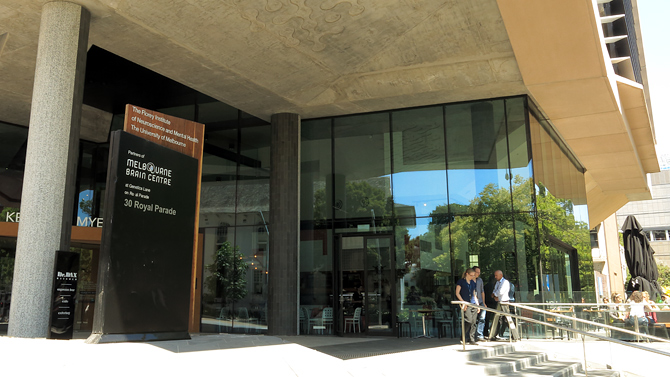
The venue: Melbourne Brain Centre
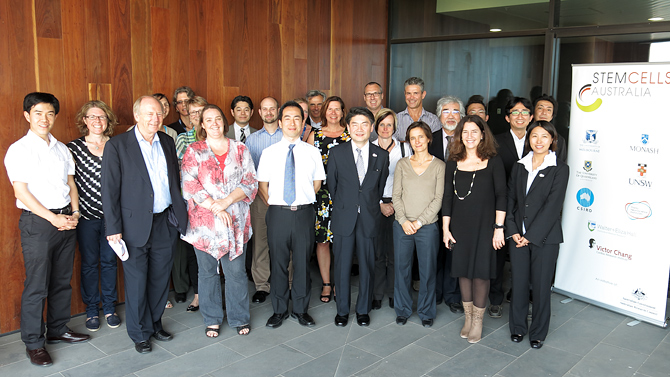
The SCA-iCeMS joint symposium delegates
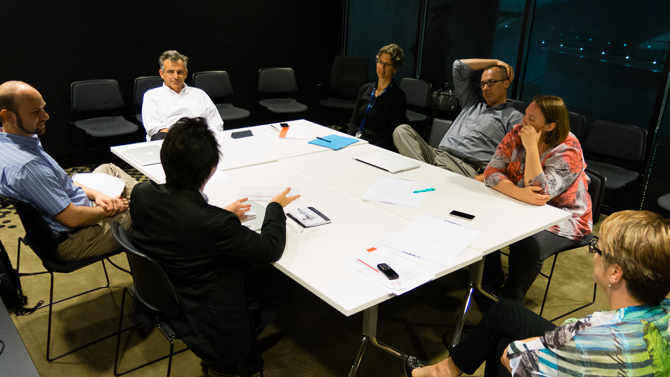
The "pluripotency and reprogramming" session speakers engage in a discussion.
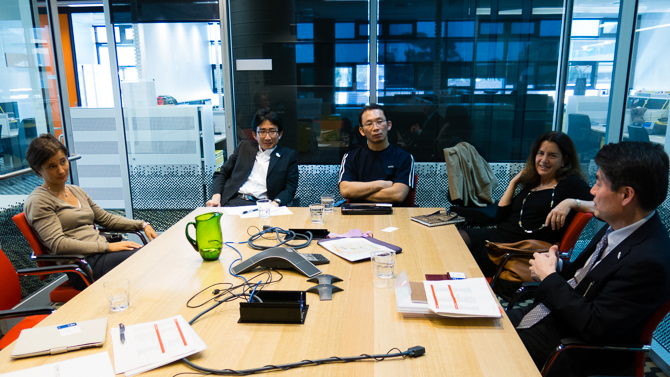
The "cardiac" session speakers engage in a discussion.
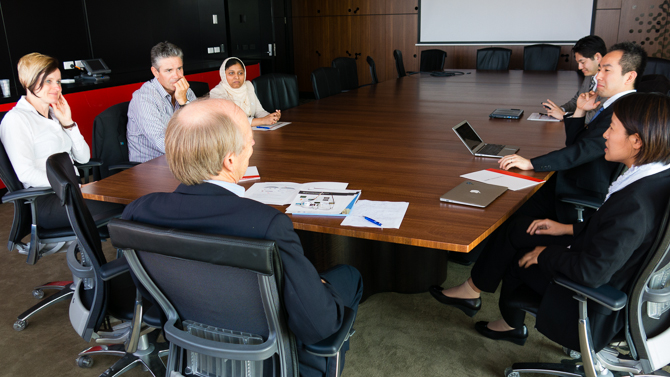
The "materials science and microfluidics" session speakers engage in a discussion.
